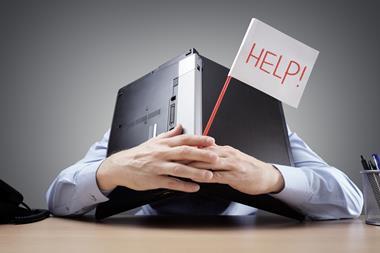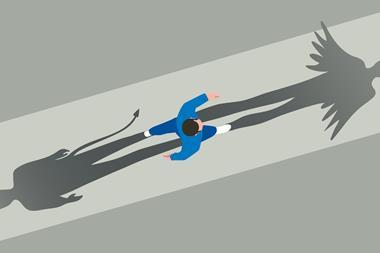This time last year, Jim Cantalupo, chief executive and chairman of McDonalds, died during a meeting of McDonalds' franchise owners. Jim Cantalupo had been widely praised for turning around the company's flagging fortunes, and his loss sent shock waves throughout the markets as share trading volumes tripled and 2.9% was knocked off the company's value within just 24 hours of the announcement - a staggering amount of money when you consider the company's market value.
It is not, however, just market confidence that can be severely affected by the loss of a senior figure. In many cases, especially in smaller companies, a great deal of information, ideas and customer trust can also be lost.
Close to your chest
Even in today's information age, much information remains locked in people's heads: discussions held with potential and existing customers; the seeds of plans for taking the company forward; unwritten deals with suppliers and customers - the list can be enormous. If your CEO had a heart attack and died tomorrow, how much of this information would be lost?
If the loss of a CEO can make such a serious dent in McDonald's market value, one can assume that smaller companies will suffer equivalent, if not worse, effects. Customer trust can be one of the first elements at risk. If your product or service is business-critical to your customers, they may quickly become concerned about your ability to maintain supply during the state of flux. Will a new leader have new visions that do not coincide with our needs? Will the company be sold? Will the new CEO realise how important we are? Will the company still focus on quality? In such a situation, loyal and happy customers may begin to test the market for alternatives.
The importance of relationships in business should never be underestimated either. When a senior figure leaves an organisation to join a competitor, contractual obligations are in place to make sure that they cannot take customers with them. These obligations highlight the importance organisations place on relationships, yet when a CEO is lost to a company through death or illness there are no safeguards. If a customer has been loyal to a senior member of staff it does not always correlate with their loyalty to the company.
All for one
All these issues create a maze of twists and turns that a company needs to navigate its way through should it lose its CEO - difficult enough with a strong leader at the helm, but with senior staff and directors all trying to safeguard their own positions and potentially vying for personal advantage, the situation becomes even more complicated.
Human nature dictates that there will be plenty of board members who consider themselves in the running as the natural successor - which means that there will inevitably be runners-up when a new CEO is found. If this results in disgruntled or disappointed directors leaving the company, and perhaps taking their up-and-coming younger managers and customers with them, then the company will be left in an even greater state of flux.
In an ideal world the answer is simple: CEO succession is a long-term process which should be led closely by the existing CEO. But a new 45-year-old CEO who plays squash on a Sunday is not expecting to have a heart attack in a Monday board meeting. A plan really needs to be in place from day one.
It should be spelled out clearly who should assume leadership if and when an emergency happens, and it is best to designate this leadership role by title rather than by name. The fact that this leadership is temporary needs reaffirming, but it is of paramount importance that someone is in place to guide the company through the first, most difficult, week. Otherwise the first week could be spent discussing who is in charge.
Even without internal wrangling, choosing a successor is not an easy task. A great deal of time and money needs to be spent finding the right person; someone who convinces investors, customers, shareholders and staff that they can successfully lead the business. Even if the perfect replacement exists, a suitable package needs to be put together to bring them to your company, and there may be other issues which could lead to even more valuable time elapsing before a new leader is in place.
Continuity
The stress on a company will continue to mount as the process of finding a new CEO drags on, so it is imperative that a company has a recovery plan in place in case of the illness or death of its CEO.
If you pick up any of the broadsheet newspapers or national business magazines you do not have to look far to spot a story about a company threatened because they did not have the right business continuity plans in place, or a company which is spending vast amounts to make sure that it can survive a disaster, be it man-made or natural.
The thriving market for IT disaster recovery tools, for example, highlights that business continuity is high on companies' agendas, and yet employees, potentially a company's most valuable asset, seem to be overlooked. It is always worth bearing in mind that a faulty or broken product can be fixed or replaced in a far faster time than it takes to replace, train and bring up to speed a new employee, especially at a senior level.
One option open to businesses is keyman insurance, a growing trend in the US, which is starting to make its way across the Atlantic. By taking out insurance on key staff, a company can ensure that it is financially compensated following the loss of a CEO or senior board member. For small companies especially, this cash injection could ensure the companies short-term survival, but this does not remedy other issues where it is difficult to establish the monetary value of loss, particularly the loss of customer and investor trust.
Safeguards
It is never going to be possible to protect your CEO and key staff from accident or illness, but within the workplace certain steps can, of course, be taken. When you consider, for example, that senior managers, directors and CEOs are more at risk of suffering from a heart attack between the hours of 8am and 11am on a Monday morning than at any other time during the week, a time when they are also most likely to be in the office, then ensuring that a defibrillator is on site and people are trained in its use could be the difference between life and death for anyone suffering a cardiac arrest.
Equally, ensuring that all health and safety procedures are adhered to, and that stress is proactively managed can reduce the risk of illness occurring.
By ensuring effective and tested plans are in place 'disaster recovery' can be turned into 'disaster avoidance'. The unexpected death of a colleague is never going to be a pleasant subject to plan for but procedures do need to be in place, especially when the survival of your company is at stake.
- Abe Elkinson is managing director of Trust Medical, www.trust-medical.co.uk HEART ATTACK IN THE OFFICE
What is a heart attack? A heart attack occurs when the heart does not get enough blood flow, leading to the death of the heart muscle.
What is cardiac arrest? Cardiac arrest is a condition in which the heartbeat stops suddenly and unexpectedly.
What is the difference between a heart attack and cardiac arrest? A heart attack is often preceded by chest, arm, upper abdomen or jaw pain. Nausea and sweating are common. There is rarely a warning before a cardiac arrest.
Heart attack patients usually remain conscious - cardiac arrest patients always lose consciousness.
What is ventricular fibrillation? Ventricular fibrillation is the most common cause of cardiac arrest. It is a rapid, chaotic, lethal rhythm of the heart.
Why is early defibrillation so important? Death from ventricular fibrillation occurs within minutes. Time is critical and defibrillation is the only effective treatment.
What is an automated external defibrillator?
It is a computerised medical device. Two adhesive electrode pads are attached to the bare chest and a microprocessor inside the defibrillator automatically analyses the patient's heart rhythm and advises the rescuer when a shock is needed. AEDs are extremely safe, accurate and easy to use.
Visit www.trust-medical.co.uk for further info.

















